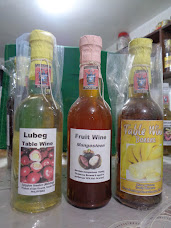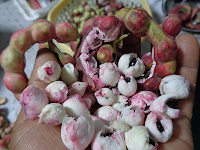BASI REVOLT of 1807
18th Century Basi Wine Cellar
at LIVING with NATURE CENTER
San Vicente, Ilocos Sur

To protect their historical and cultural integrity, President Rodrigo Duterte declared Cebu's Carcar City and Ilocos Sur's San Vicente town as Heritage Zones. These are provided under Republic Act 11644 and 11645 signed by the President into law last January 14, 2022.
Under RA No. 11645, the heritage zone in San Vicente shall include the “cultural properties declared as National Cultural Treasures and Important Cultural Properties as well as National Historical Landmarks, Shrines, Monuments, and Sites, and such other immovable, movable or intangible cultural properties whether publicly or privately owned.”
Basi Wine Sparked a Revolution in 1807. This article is dedicated to the Filipino heroes and their descendants of the Basi Revolt of 1807.

LIVING with NATURE CENTER
San Vicente, Ilocos Sur
[avrotor.blogspot.com]
Basi sparked one of the major revolts against Spanish rule by the natives when wine monopoly was declared by the government. This meant virtually taking the industry from the hands of the natives. The short-lived uprising took place in Ilocos, with the final battle fought on both sides of the Bantaoay River which runs through the towns of San Vicente up to San Ildefonso, which are today the major suppliers of Basi principally to tourists in Vigan, UNESCO's world heritage city, and one of the cultural wonders of the world.

I grew up with an old local industry – basi wine making. Today there are still 18th century jars, which I use in the way my ancestors made the wine for generations.
Basi Table Wine - Pride of the Ilocos Region
I remember Lolo Celing (Marcelino) made basi in the cellar, the ground floor of our house made of thick brick wall. In dad's time we had around 500 jars. He was one of the biggest basi brewers in during the Commonwealth era, and probably after the infamous Basi Revolt in 1807 when the Ilocanos took arms but lost to the Spaniards who took monopoly over the industry. Many were killed in that short-lived revolt along the Bantaoay River, a river where my brother Eugene and I used to fish purong (mullet) in summer.
Bantaoay is a barangay of San Vicente through which the river passes. It is for this that the barangay got its name.
Getting drunk at an early age
I was already a farmhand before I was of school age, but dad always warned me not to be an aliwegweg (curious at doing things), the experimenter that I was. One morning as dad went on his routine, first to hear mass in our parish church just across our residential farm, I went down to the cellar with a sumpit (small bamboo tube) to take a sip of the sweet day-old fermenting sugarcane juice. I didn't know that with a sip too many one can get drunk. And that was precisely what made me feel sick, but 1 did not tell dad. He called a doctor to find out what was the matter with me. When the doctor arrived he found me normal. What with the distance from Vigan to San Vicente - on a caleza (horse-drawn carriage)? . But the doctor was whispering something to dad.
Then it happened. Dad had left for the church, so I thought. I went to the cellar and as soon as I probed the sumpit into a newly fermenting jar and took a sip, someone tapped my shoulder in the dark. It was dad!
Imagine the expression of his face (and mine, too) in the dark. I sobbed with embarrassment while he took a deep sigh of relief. Since then the doctor never came again. And I promised dad never to taste my “beverage" again.
Sunset and revival of the basi industry
Years passed. I left home for my studies in Manila, so with my brother and sister. Dad continued the industry until he became very old. By then the demand for the local drink declined as beer and all kinds of wine and liquor, local and imported, began flooding the market. It was requiem to a sunset industry. In 1981, dad died, so with our home industry.
Even after finishing agriculture I did not go back to the farm. So with my brother who also became an agriculturist. Not when you are young and thinking of adventure and opportunities. I pursued advanced studies in biological science. Eugene went back to the farm later, so with our sister, Veny, who joined the Divine Word College of Vigan faculty. But the thought of reviving basi was never in our mind.
For how can a local product sell in a highly competitive market? Foreign products have been flooding the market under the import liberalization program of the government. Other questions propped up, but all boiled down to one possible solution - business viability.
As a researcher I studied the indigenous process of basi making. After I had sufficient materials about the subject I made it into a paper which I read in an ASEAN-New Zealand symposium upon the recommendation of Dr. Romualdo del Rosario, a fellow professor at the UST Graduate School. But the native product needed improvement. It was at first a losing proposition, and I realized I was blazing a lost path. But I did not give up.
When I opted for an early retirement from government service in 1989 I found more time with my experiments. The improved product was analyzed by the Food Development Center, a government agency that collaborates with the US Food and Drug Administration. Surprisingly the new basi product passed the European standard for champagne, sherry and port.
But it was no guarantee that it is acceptable in the market. It means that if the product is really that good, it can command a premium price. I began to standardize the product. Soon I was able to establish a consistent level of strength (proof), desired range of acidity, and crystal clear color and clarity. There was improvement in aroma, bouquet, sweetness, aftertaste, among other criteria, which constitute international standards for wine. All these were done in various experiments, often in trial and error method, in others through intricate laboratory procedures. Still in others, only after a yearlong aging of the wine.
Lastly, I began working on product presentation. The labels I developed are a series of color photographs of historical places of the Ilocos Region, and the story of the Basi Revolt of 1807.
A breakthrough came after receiving the Business Idea for Development and Achievement (BIDA) Award, and a favorable product endorsement by the Department of Agriculture (MARID). Other than the Ilocano balikbayan, the market expanded to include tourist shops, wine connoisseurs, and even church groups.
I am sure Dad must be smiling up there. Here is a toast for you, Dad. ~
Basi is ideally aged 2 to 5 years in earthen jar sealed hermetically with hard clay.
Author shows golden leaves of samat (Macranga tenarius), and bubod (local yeast complex culture), which are principal ingredients in basi making.
Part 2: Basi Revolt of 1807 in Paintings
Location: Bantaoay River, San Vicente, Ilocos Sur (San Vicente IS Series)
Basi Revolt 1807 - Paintings by Esteban Villanueva
The revolt took place 400 km north of Manila where Diego and Gabriela Silang heroically fought Spanish rule 50 years before. It was precipitated by the declaration of Wine Monopoly by the local Spanish government that virtually took from the hands of small cottage brewers an industry the Ilocos region enjoyed long before Spain colonized the islands. Basi was carried by the Galleon trade plying Ciudad Fernandina (now Vigan City) and Europe via Acapulco, Mexico (1565-1815).
The final battle took place along the Bantaoay River that runs through the town of San Ildefonso on the East and San Vicente on the West, some 4 km from the capital (Vigan) where the industry flourished. Scores of Spanish soldiers and natives were killed. Although the revolt spread to as far as Ilocos Norte, and Pangasinan to the south, it culminated on September 29, 1907 with the public execution of the captured rebels.
Fourteen big oil paintings depicting the Basi Revolt, also known as Ambaristo Revolt (named after its leader) can be seen today at the Padre Burgos House - National Museum in Vigan, the original residence of Filipino priest martyr, Fr. Jose Burgos. The painter, Don Esteban Villanueva was an eyewitness of this historic event.
Today, the Basi Revolt lives on with the fine taste and tradition of this unique product standing among the best wines of the world. Nine of the paintings are posted here.
Basi is the flagship of wine products of San Vicente Ilocos Sur which include fruit wine from chico, pineapple, dragon fruit, guava, and the like, and the popular sukang Iloko (Ilocos Vinegar).
Part 3: Rotor Basi receives BIDA Award
Part 3: Rotor Basi receives BIDA Award
Rotor Basi won the distinct Business Development Development Award (BIDA) in 2000. The prize inspired the revival of a sunset industry in the Ilocos Region. Left photo, the late former administrator Jesus T Tanchanco (right) of the National Food Authority and Mrs Alice Tanchanco pose with the author after receiving the BIDA Award. Right photo, members of the winning team receive the cash award from BIDA, a joint project led by DOST and DTI (Small and Medium Industries), Philippine Chamber of Commerce and Industry (PCCI), and Planters Bank of the Philippines.

Rotor Basi (made in San Vicente Ilocos Sur) has labels depicting the Ilocos Region's historical events, landmarks, and outstanding natives of the region - Ilocanos. Basi is a major attraction to tourists from different parts of the world. Basi is the only kind of table wine in the world. Basi as well as its by-product, Ilocos Vinegar (suka ti Ilocos, or sukang Iloko to the Tagalogs) meet rigorous European standards and US Food and Drugs Administration tests.


The distinct mellow taste of basi comes largely from its aging time in burnay (earthen jars) - perhaps the only kind of tropical table wine processed and aged in this respected age-old tradition. The jars are kept for as long as ten years in home cellars or buried in the ground, and sealed hermetically with hard clay. Basi was once an important article of commerce in the region, and when the islands were colonized by Spain, basi reached Europe via the Galleon Trade passing through Acapulco, the southern tip of Mexico.~
Part 4: Universal Formula of Basi Wine in Making Table Wine
Fruit Wine from Local Fruits in Season
Dr Abe V Rotor
Table wine from different local fruits produced at San Vicente Botanical Garden. under the supervision of the author. San Vicente, Ilocos Sur
Yes, you can make wine from many fruits, particularly those in season.
1. Choose the fully ripe fruits, fresh and without blemishes.
2. Discard over ripe fruits and those with injury and signs of pest and diseases.
3. Wash thoroughly, remove peduncle, stem, leaves, dirt.
4. Slice thinly (banana), peel but include rind (rambutan), remove seeds from pulp and skin (mango), mash, remove seed (duhat), peel off and include skin (piña).
5. Add red (natural) sugar to raise sugar content twice that of the sugar in the particular fruit.
6. Add equal amount of water (liter) to weight fruit and sugar (kilo). This is the must.
7. Add to the must baker's yeast, 1 tbsp per 5 liters of must.
8. Use glass jar or earthen jar (tapayan or burnay). Don't use plastic bottles.
9. Seal with cotton to allow gas to escape during fermentation. Warning: Container may break if cover is tight.
10. After 15 to 20 days, decant - transfer filtrate to another container for aging for at least one year. Seal airtight. Use sediment for feeds, or make it into compost.
11. Keep in cool and dark place for the entire aging period.
12. Harvest. Say a little prayer. Serve as is, or chilled. Congratulations!
Yes, you can make wine from many fruits, particularly those in season.
1. Choose the fully ripe fruits, fresh and without blemishes.
2. Discard over ripe fruits and those with injury and signs of pest and diseases.
3. Wash thoroughly, remove peduncle, stem, leaves, dirt.
4. Slice thinly (banana), peel but include rind (rambutan), remove seeds from pulp and skin (mango), mash, remove seed (duhat), peel off and include skin (piña).
5. Add red (natural) sugar to raise sugar content twice that of the sugar in the particular fruit.
6. Add equal amount of water (liter) to weight fruit and sugar (kilo). This is the must.
7. Add to the must baker's yeast, 1 tbsp per 5 liters of must.
8. Use glass jar or earthen jar (tapayan or burnay). Don't use plastic bottles.
9. Seal with cotton to allow gas to escape during fermentation. Warning: Container may break if cover is tight.
10. After 15 to 20 days, decant - transfer filtrate to another container for aging for at least one year. Seal airtight. Use sediment for feeds, or make it into compost.
11. Keep in cool and dark place for the entire aging period.
12. Harvest. Say a little prayer. Serve as is, or chilled. Congratulations!
Preparing the must in earthen jars: rambutan (above), and banana. Lower photo, author checks final composition of banana must with yeast.
Table Wine from 12 common tropical fruits.
1. Mango
2. Guyabano
3. Pineapple
4. Guava (native)
5. Duhat
6. Dragon Fruit
7. Sineguelas
8. Rambutan
9. Nangka
10. Macopa
11. Chico
12. Banana
2. Guyabano
3. Pineapple
4. Guava (native)
5. Duhat
6. Dragon Fruit
7. Sineguelas
8. Rambutan
9. Nangka
10. Macopa
11. Chico
12. Banana
Other indigenous fruits in the Philippines
13. Limonsito
14. Aratilis
15. Macopa
16. Lubeg
17. Kamachile
18. Caimito
19. Mansanitas (Aratiles)
20. Bignay
Other fruits
21. Pomegranate
22. Aplas (wild fig)
23. Lanzones
24. Marang
25. Limonsito
NOTE: Vinegar (vin-egar or sour wine) may be produced from the same fruits. Thus, fruit wine can be made into vinegar (e.g. tamarind vinegar, pineapple vinegar) through the process of acetification. Acetic acid or vinegar (CH3COOH) is oxidized ethanol (C2H5OH + O2).




Fruits in season come plentiful that otherwise go to waste. Make fruit wines from them instead. And vinegar, too, which is a by-product of wine making. The formula follows basically that of basi wine making. Here are two dozen kinds of fruit wine made from local fruits, from macopa to guava, and from wild species, Is-is (Ficus) to Aratiles (Muntingia). You can also make Mead (Honey wine) from local honey.
Here are some fruits that make excellent Table Wine
Siniguelas (Spondias purpurea) Family Anacardiaceae;
macopa (Eugenia jambolana) Family Myrtaceae
sampalok (Tamarindus indica), Family Leguminosae
Pomegranate (Punica granatum), family Lythraceae, subfamily Punicoideae;camachile (Pithecollobium dulce) Family Leguminusae.
---------------------------------------------
Back Label: Philippine History – The Basi Revolt of 1807
The revolt erupted 400 km north of Manila, where Diego and Gabriela Silang fought heroically against Spanish rule 50 years earlier. The cause: Declaration of Wine Monopoly by the Spanish government virtually taking from the hands of local brewers an industry the Ilocos region had long enjoyed even before Spain colonized the islands. For centuries basi was an important item of commerce among Asian neighbors, and later with the Galleon Trade (1565-1815) plying Ciudad Fernandina (now Vigan City) and Europe via Acapulco, Mexico. The final battle took place along Bantaoay River with scores of Spanish soldiers and natives killed. On September 29, 1807 the captured rebels were executed. Artist Don Esteban Villanueva, an eyewitness recorded the historic event in 14 big paintings, now seen at the Vigan Ayala Museum at the original residence of priest martyr, Fr. Jose Burgos. This bottle is a tribute to the heroes of the Basi Revolt and their descendants. Today basi stands among the finest wines of the world.
Product Guarantee: Basi is brewed and aged in glazed jars (burnay. It is made from sugarcane, rice, and botanical ingredients - Pithecolobium dulce, Macaranga tanarius and Syzigium cumini. No flavoring and coloring added; no filter and plastic container used. This product meets the European Standard for Champagne, Port and Sherry. (Reference: PFDCS 2498 & PFDCS 9429, Food Development Center, National Food Authority.) Approximately 21 proof. (Ref: 01-00-0CL-0017, ITDI, Department of Science and Technology.) A product of San Vicente, Ilocos Sur, Philippines. Content: 750 ml/375 ml.
















.jpg)

















No comments:
Post a Comment